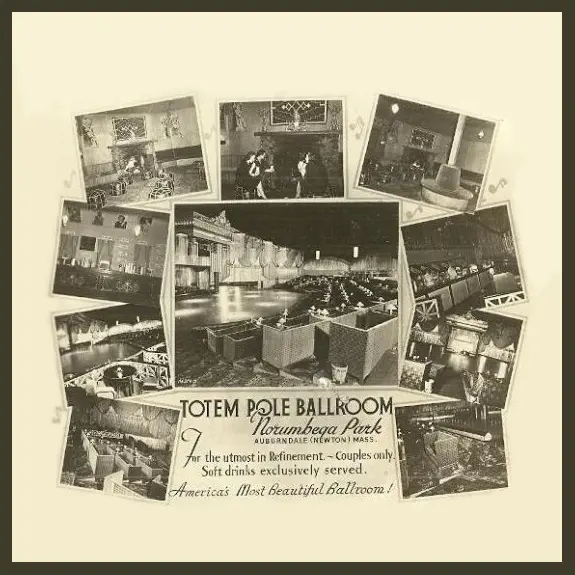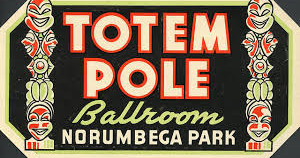Totem Pole Ballroom

Totem Pole Ballroom
Out to Norumbega
By the winding riverside
It’s in the garden city
And it’s everybody’s pride
It opened in June of 1897 and closed forever on Labor Day 1963. That was Norumbega Park—in the Boston vernacular, pronounced as “Nor-um-bee-ga Pahk”—located in Auburndale Massachusetts by the Charles River—and considered at the time as one of the most beautiful parks in America. There is a lot of myth around the name Norumbega—which according to Wikipedia was “a legendary Nordic settlement in northeastern North America which was featured on many early maps from the 1500s until European colonization of the region where it is also alleged that the houses had pillars of gold and the inhabitants carried quarts of pearls on their heads.” While some of that might be debated and disputed, the fact remains that Norumbega Park was a hotbed of outdoor recreational activity for 66 years.
Then, beginning in the spring of 1930, the park was also the site of the Totem Pole Ballroom, a premier musical venue of its time, whose stage featured swing bands and big bands alike that were revered by many and enjoyed by patrons from across the Boston area and beyond. Considered America’s most beautiful ballroom at the time, people came for relaxation, listening to great music, and of course dancing. Virtually every famous swing band in the country appeared at The Totem Pole including Benny Goodman, Artie Shaw, Harry James, the Dorsey Brothers, Gene Krupa, Guy Lombardo, and Frank Sinatra. Music from the ballroom was broadcast locally over WNAC Boston and nationally over the NBC, ABC and CBS networks.
Originally an open-air theatre, which limited its use to only good weather conditions, The Totem Pole was eventually closed in and converted to a ballroom with three separate dance floors. The main stage featured two totem poles, one each to the left and right of the stage which obviously led to name of the infamous venue.
I might hesitate to call it The Rat (aka The Rathskellar) of its day but, just as the Rat was considered one of Boston’s premier music venues, this must have conveyed a similar feeling and vibe. Like the Rat, it was referred to as “The Pole” but with a few notable exceptions. There was no drinking allowed and no erratic behavior. Men wore suits and ties and women stocking and dresses. Admission was only $1.75. However, beginning in 1940 the rules got more restrictive and you could only go there as a couple. This was in response to more men going there stag to see the bands perform and crowding around the stage which left couples less room for dancing. That would have been me inching my way past the dancers to the front of the stage to see the likes of Buddy Rich on drums.
When you were not dancing, for a mere fifty cents you could reserve a two-person loveseat and for a dollar a four-person sofa—comfortable gray velvet couches with high sides for privacy where couples might be able to steal a kiss or two—considered very daring at the time.
I recall my parents talking about the park and specifically the music venue located there and it is quite possible that my Dad and his brother even performed there as they were pianist and saxophonist respectively and not only performed with their own ensembles but also sat in with many local swing and polka bands during the fifties. These were the bands that attracted people who wanted and that loved to dance. And so along with the music and notable performers of the day, dancing was the main attraction to The Totem Pole. In my quest to learn more about it and perhaps hear from some folks that experienced the Totem Pole in its heyday, I started asking some older people I knew if they had ever known about or frequented the Totem Pole. To my surprise and delight, I discovered two of them straight away.
The first was Lois Murphy, a neighbor of mine here in Houghs Neck (a section of Quincy) who first experienced the Totem Pole as a 19-year-old and just out of high school on her first job. According to Lois, she was this cute little redhead and was asked out by a flirtatious co-worker named George if she fancied going dancing to which she agreed. She had no idea where they were going but it turned out to be a very crowded Saturday evening at the Totem Pole at which she says, “I thought I died and went to heaven” and to find that it happened to be Tommy Dorsey performing.
The other amazing thing to Lois was that George seemed to be very well known among the crowd and at one point asked Lois to sit for a bit while he got up and played clarinet with the band. It turns out that George was a frequent performer at The Totem Pole and was known for sitting in with other bands—much like my Dad and Uncle had done when some of the more well-known performers were around town. That first experience led Lois toward a record buying spree, picking up as many Tommy Dorsey records as she could find. Lois’ very next experience at the Totem Pole was her very first date with the man that she would eventually marry. Not a bad run for a twofer Totem experience.
The second person I discovered to have experienced The Totem Pole was Mary Ann Ohrenberger, my wife’s mother who first went there during the early-1950s who described it as elegant and being in awe of the nightclub ambiance along with theatre style tiered seating from which you could easily view the stage and the dance floor. She recalls going there by trolley from Waltham “all decked out” because you knew you were going someplace very special. Two performances that really stood out to her were Lawrence Welk and Rosemary Clooney along with her sister Betty Clooney. She heard Rosemary’s sing that hit song of her “Come On-A My House” with the lyrics that went “Come on-a my house, my house, I’m gonna give-a you candy,” which sounds a bit alluring and suggestive for its time. Naturally during the mid-fifties, the Totem Pole was “couples only” and she only went there with her husband—the main attraction of course being the performers but not to detract from the fact that there was a lot of dancing to the music.
Seasons change and so did the park and The Pole. With more highways like Route 128 allowing people to travel up North into the mountains and further away from home for entertainment, the popularity for both Norumbega and The Totem Pole waned. On November 10, 1965, a year after the final note was played at the Totem Pole, a fire burned it completely to the ground—ending an era of ballroom dancing at Norumbega Park. The city of Newton has preserved ten acres known as the Norumbega Park Conservation Land. It has access to the Charles River and is a popular jogging and dog-walking site during the day.
(by Karl Sharicz)






